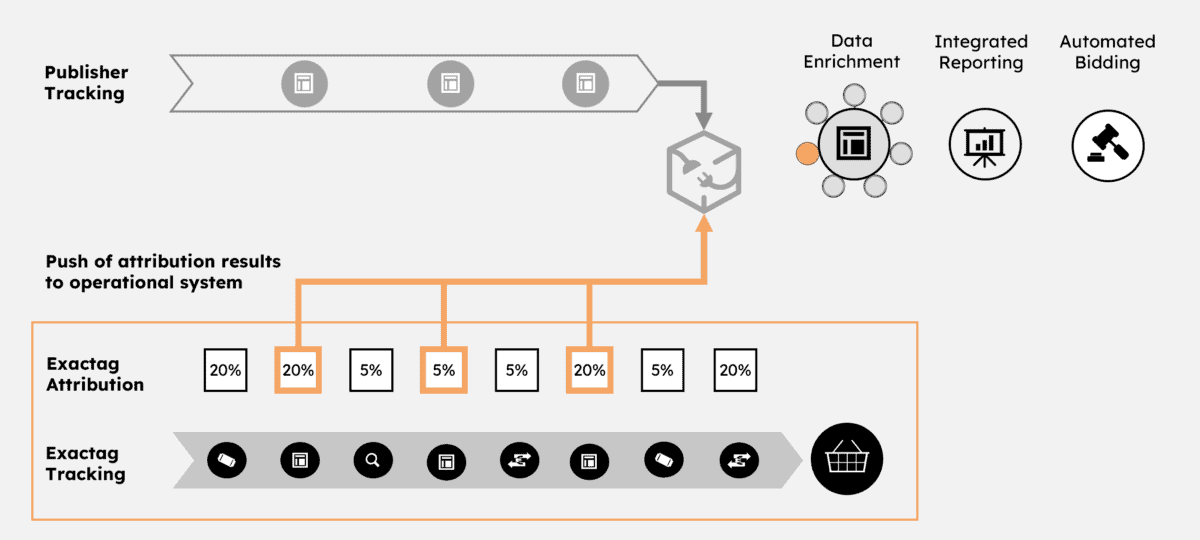Navigating the Landscape
An Examination of Exactag and Google's measurement solutions for today’s top digital marketing challenges

Digital marketing, despite its fantastic opportunities, presents unique challenges, especially when it comes to performance measurement. Marketers search for reliable measurement solutions that best solve their challenges in a world full of new data, legislation, and platform limitations.
There are 3 hurdles to take.
- Ensuring cookieless tracking.
- Managing non-consented data.
- Automated Bidding based on attribution results.
To address these, let’s look at our solution and describe Google’s approach to these challenges for better understanding and comparison.
As a digital marketing giant and a crucial publisher for most advertisers, Google has initiated strategies to overcome these obstacles, which many advertisers will be familiar with.
Cookieless tracking
In light of heightened privacy concerns, the phasing-out of third-party cookies has made tracking user interaction, particularly view tracking, more challenging.
We address these with our “Full View Impact” cookieless tracking. This evaluates touchpoints on a micro-aggregate or campaign level, using Structural Times Series Analysis to model their impact.
No personal data is used, it incorporates consented and non-consented users, and is applicable to any publisher, reducing regulatory risks and maintaining neutral attribution.

Google’s solution, Enhanced Conversions, collects first-party data shared by the user during conversion. Personal identifiers like name and address are hashed by Google and sent to its servers for processing.
Google attempts to match this hashed data with the hashed versions of identifiers it already has, from when users signed in to their Google accounts. This allows it to match conversions with Google touchpoints on a user level.
So why did we choose a different approach to Google?
- Measurement providers like Exactag do not own a database that allows user data matching to this extent.
Nevertheless, we refused to follow any matching approach due to the privacy and reputational risks, as there’s a potential risk of regulation, with experts anticipating the need for additional user consent. Advertisers also need to be aware that the data might not only be used for their use case.
- We want to keep measurement as neutral as possible. Treating Google touchpoints differently compared to others can lead to biased results.
Our approach also accommodates non-consented users, as not doing so would again negatively impact accuracy.
Non-consented Data
Ignoring non-consent bias can lead to considerable inefficiencies in digital marketing.
We offer a micro-aggregated measurement solution for handling non-consented data. Only group keys, device types, and campaign information are collected. This data doesn’t allow fingerprinting but enables us to apply our attribution algorithms.
We identify patterns that drive efficiencies and disclose channels, providers, and campaigns that deliver incremental uplift. Data is stored in Germany throughout the process, eliminating the need for international data transfers. And no personal data is stored or used for fingerprinting.
In Google’s Consent Mode, when users don’t consent, Google refrains from setting cookies but sends cookieless pings to its servers. These contain aggregated and functional information like timestamps, referrers, and user agents. Google then uses patterns from its consented users to model non-consented user journeys, where possible.
Once again,
our approach differs:
A recent Exactag study revealed that non-consented and consented users are very different. And these differences are not stable across industries and time.
Deterministic data can best describe the behavior of both groups and ensures that results reflect the status quo. Probabilistic modeling comes with a risk of biased results and can’t deliver results for all non-consented conversions.
We refrain from using any data that allows fingerprinting, as this raises concerns from users, privacy-conscious marketers, and the authorities.
Finally, we prefer giving advertisers full access and control over tracking and data. Our approach allows us to integrate all data into the advertisers’ database.
Automated Bidding based on Attribution
Automated Bidding optimizes efficiency for advertisers, allowing target metric-based bidding without daily manual effort. Publishers like Google, Microsoft, and Criteo provide APIs enabling the ingestion of attribution data into their bid engines.

We developed “Attribution Push” to send granular attribution results to a publisher. For Google Ads, we use Google’s “Offline Conversions”.
This API allows us to push fractional shares to Google for each Google touchpoint within a customer journey. This provides a transparent assessment of platforms, tactics, campaigns, etc.
Google recommends advertisers use the Conversion Adjustment API instead to upload attribution data. This new API supports Google features such as Consent Mode (see above).
But using the Conversion Adjustment API only allows you to send data per conversion, not per individual touchpoint. This means that results for all Google touchpoints within a journey must be summed up and then sent to Google.
And yes, why do we promote the first approach here?
Because:
- We prefer granular data.
The aggregation of touchpoint results to an order level suppresses the differentiation of platforms, tactics, and campaigns.
- With complete granularity, we ensure transparency and control for the advertiser.
Conclusion
As the digital landscape evolves, so must our approaches to measuring performance. Google’s new solutions enable a broad group of marketers to tackle pressing challenges.
Our solutions, however, present a compelling alternative, mitigating the risks associated with Google’s approaches while ensuring precision, neutrality, and control.
For any further questions, please don’t hesitate to contact us.
We are happy to hear from you.
And also
Please read our detailed overview to learn more about all differences between GA4 and Exactag.